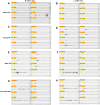Impact of an upper limb motion-driven virtual rehabilitation system on residual motor function in patients with complete spinal cord injury: a pilot study
- PMID: 40045360
- PMCID: PMC11881371
- DOI: 10.1186/s12984-025-01587-y
Impact of an upper limb motion-driven virtual rehabilitation system on residual motor function in patients with complete spinal cord injury: a pilot study
Abstract
Background: Assessing residual motor function in motor complete spinal cord injury (SCI) patients using surface electromyography (sEMG) is clinically important. Due to the prolonged loss of motor control and peripheral sensory input, patients may struggle to effectively activate residual motor function during sEMG assessments. The study proposes using virtual reality (VR) technology to enhance embodiment, motor imagery (MI), and memory, aiming to improve the activation of residual motor function and increase the sensitivity of sEMG assessments.
Methods: By Recruiting a sample of 12 patients with AIS A/B and capturing surface electromyographic signals before, druing and after VR training, RESULTS: Most patients showed significant electromyographic improvements in activation frequency and or 5-rank frequency during or after VR training. However, one patient with severe lower limb neuropathic pain did not exhibit volitional electromyographic activation, though their pain diminished during the VR training.
Conclusions: VR can enhance the activation of patients' residual motor function by improving body awareness and MI, thereby increasing the sensitivity of sEMG assessments.
Keywords: Residual motor control ability; Spinal cord injury; VR; sEMG.
© 2025. The Author(s).
Conflict of interest statement
Declarations. Ethics approval and consent to participate: The study procedures were approved by the Medical Ethics Committee of China Rehabilitation Research Center (approval No. 2020-014-1, April 1, 2020) and were conducted with the informed consent of all participants. Consent for publication: In the experiment, participants agreed to have their experimental data used for publication, and this part of the agreement is written in the informed consent form(approval No. 2020-014-1, April 1, 2020) for the experiment. Competing interests: The authors declare no competing interests.
Figures





Similar articles
-
Interactive Virtual Ankle Movement Controlled by Wrist sEMG Improves Motor Imagery: An Exploratory Study.IEEE Trans Vis Comput Graph. 2024 Aug;30(8):5507-5524. doi: 10.1109/TVCG.2023.3294342. Epub 2024 Jul 1. IEEE Trans Vis Comput Graph. 2024. PMID: 37432832
-
Upper limb rehabilitation after spinal cord injury: a treatment based on a data glove and an immersive virtual reality environment.Disabil Rehabil Assist Technol. 2016 Aug;11(6):462-7. doi: 10.3109/17483107.2015.1027293. Epub 2015 Jul 16. Disabil Rehabil Assist Technol. 2016. PMID: 26181226 Clinical Trial.
-
Characterization of Volitional Electromyographic Signals in the Lower Extremity After Motor Complete Spinal Cord Injury.Neurorehabil Neural Repair. 2017 Jun;31(6):583-591. doi: 10.1177/1545968317704904. Epub 2017 Apr 26. Neurorehabil Neural Repair. 2017. PMID: 28443786 Free PMC article.
-
Virtual Reality Systems for Upper Limb Motor Function Recovery in Patients With Spinal Cord Injury: Systematic Review and Meta-Analysis.JMIR Mhealth Uhealth. 2020 Dec 3;8(12):e22537. doi: 10.2196/22537. JMIR Mhealth Uhealth. 2020. PMID: 33270040 Free PMC article.
-
[Effectiveness of the virtual reality in the rehabilitation of the upper limb in the spinal cord injury. A systematic review].Rev Neurol. 2019 Aug 16;69(4):135-144. doi: 10.33588/rn.6904.2019034. Rev Neurol. 2019. PMID: 31334556 Spanish.
References
-
- Kakulas BA. Pathology of spinal injuries. Cent Nerv Syst Trauma. 1984;1(2):117–26. - PubMed
-
- Kakulas A. The applied neurobiology of human spinal cord injury: a review. Spinal Cord. 1988;26(6):371–9. - PubMed
-
- Kakulas B. Neuropathology: the foundation for new treatments in spinal cord injury. Spinal Cord. 2004;42(10):549–63. - PubMed
-
- Bunge RP, Puckett W, Becerra J, et al. Observations on the pathology of human spinal cord injury. A review and classification of 22 new cases with details from a case of chronic cord compression with extensive focal demyelination. Adv Neurol. 1993;59:75–89. - PubMed
-
- Dimitrijevic M, Faganel J, Lehmkuhl D, Sherwood A. Motor control in man after partial or complete spinal cord injury. Adv Neurol. 1983;39:915–26. - PubMed
MeSH terms
Grants and funding
LinkOut - more resources
Full Text Sources
Medical

